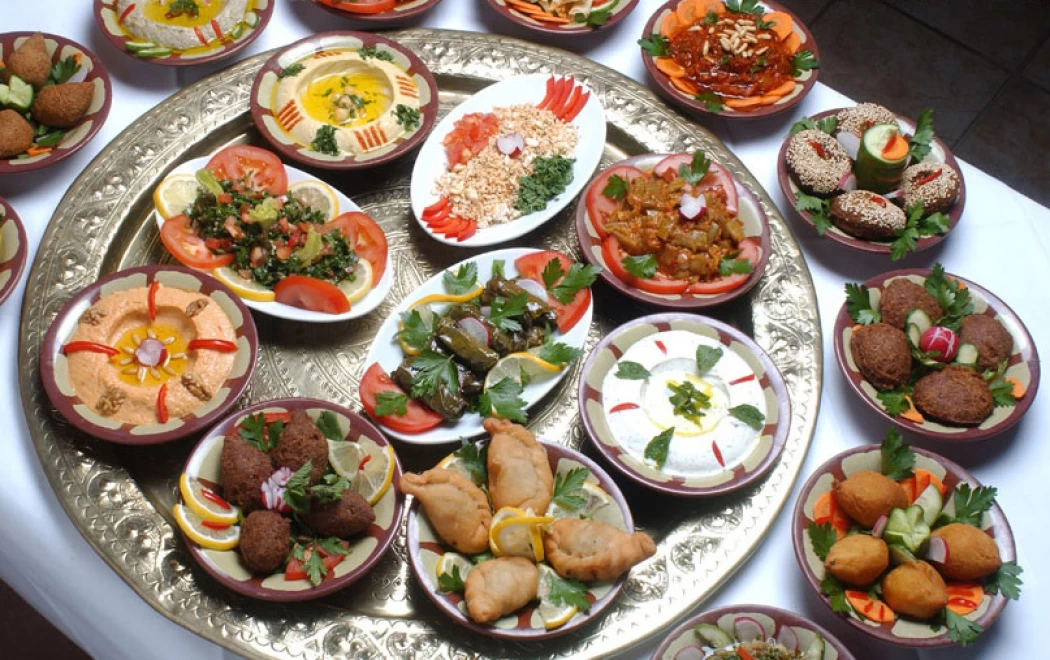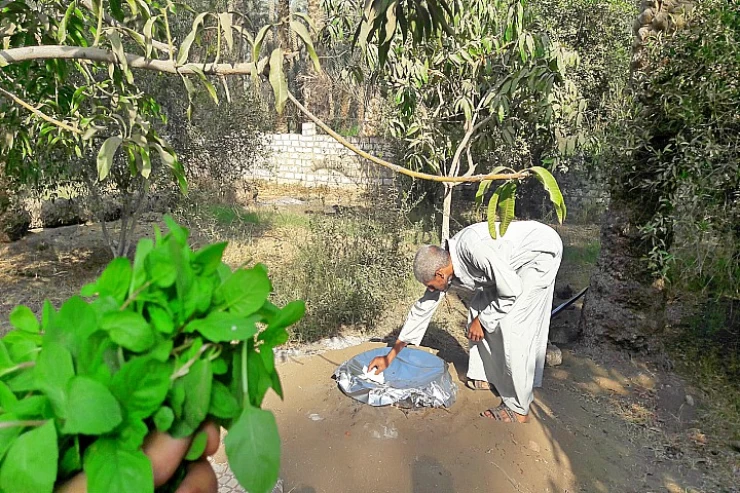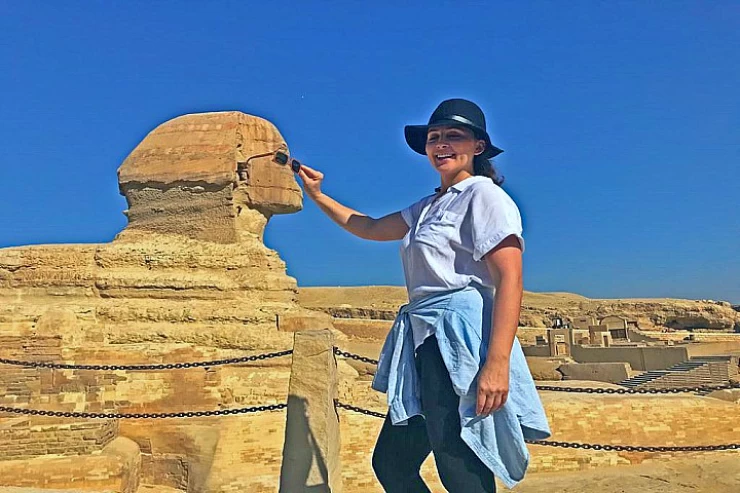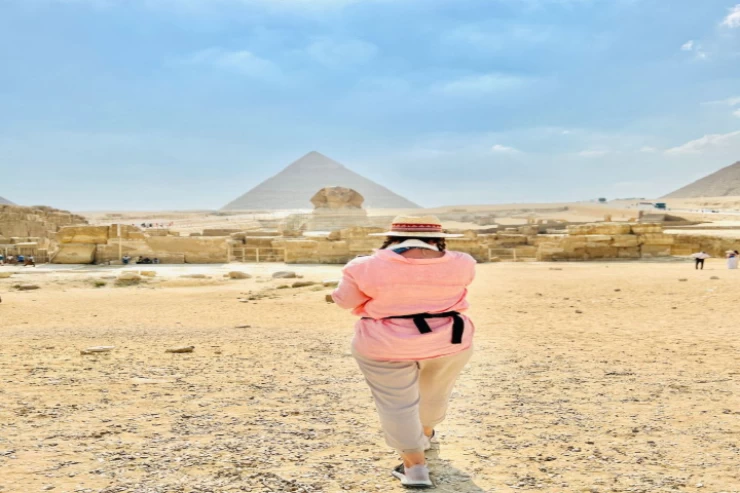
Cozinha egípcia
Cozinha egípcia
A cozinha egípcia faz uso pesado de legumes, verduras e frutas do rico Vale do Nilo e do Delta do Egito. Compartilha semelhanças com os alimentos da região do Mediterrâneo oriental, como legumes recheados de arroz, folhas de uva, shawarma, kebab e kofta.
Receitas da antiga culinária egípcia
Exemplos de receitas egípcias incluem medames completos que são feijão de fava amassado; kushari, lentilhas e massas; e molokhia, guisado de quiabo do mato. O pão Pita, conhecido localmente como Baladi de peixe, e a fabricação de queijo no Egito datam da 1ª Dinastia do Egito, sendo o queijo feta o tipo mais comum de queijo consumido atualmente.
Como o Egito é o primeiro país agrícola do mundo e, portanto, o prato mais saudável do curso mundial da cozinha egípcia, sua refeição inclui proteínas, vegetais, carboidratos, vitaminas e ferro, portanto o prato é uma refeição completa e saudável.
Carnes comuns na cozinha egípcia são coelhos, pombos, frangos e patos. Cordeiro e carne bovina são normalmente utilizados para grelhados. O Falafel é um dos famosos fast foods do Cairo, e as tortas de sobremesa preparadas na região há pelo menos 2500 anos. Além de peixes e frutos do mar comuns nas áreas costeiras do Egito, a mais famosa delas é a cidade de Alexandria. Há uma grande quantidade de comida vegetariana egípcia, devido tanto ao preço relativamente alto da carne quanto às necessidades da comunidade cristã copta, cujas restrições religiosas exigem essencialmente dietas vegetarianas durante a maior parte do ano.
A bebida do chá é a bebida nacional do Egito, onde os egípcios aprenderam de muitas maneiras a fazer chá onde você pode tomá-lo em qualquer lugar em um café local, talvez durante seus passeios no Cairo no café Al Fishawy, e o café vem em segundo lugar, a cerveja é a bebida alcoólica mais popular. Enquanto o álcool é um tabu religioso e os muçulmanos e coptas comprometidos tendem a evitar bebidas alcoólicas, o álcool está prontamente disponível no país.
As sobremesas populares no Egito incluem baklava, Deborah, konafa e Zeinab de swabe. Os ingredientes comuns nas sobremesas incluem tâmaras, mel e amêndoas.
A cozinha egípcia é particularmente inclinada para as refeições vegetarianas porque depende muito do feijão e dos pratos vegetarianos. Embora a comida em Alexandria e nas cidades costeiras do Egito tenda a utilizar uma grande quantidade de peixes e outros frutos do mar, a cozinha egípcia difere de uma província para outra, mas, na maioria das vezes, depende de alimentos que crescem fora da terra.
Os portos do Mar Vermelho egípcio foram o primeiro ponto de entrada principal para as especiarias da Europa, pois várias especiarias foram facilmente acessíveis ao longo dos anos, e essas especiarias deixaram sua marca na culinária egípcia, como o cominho, que é considerado uma das especiarias mais utilizadas. Outras especiarias comuns incluem coentro, pimenta, pimenta preta, anis, folhas de louro, endro, gengibre, canela, menta e cravinho.
Entre as carnes comuns encontradas na cozinha egípcia estão coelhos, pombos, aves e patos. É frequentemente cozido para fazer caldo para várias sopas e sopas. Cordeiro e carne bovina são a carne mais comumente usada em churrascos. Carnes grelhadas como kofta (kofta), kebab (kebab) e fatias grelhadas são denominadas intermitentemente como churrasco.
É popular no Egito, nas entranhas de animais e em várias carnes. O fígado e os sanduíches especializados em Alexandria estão entre os mais famosos fast-food do país. Pedaços picados de fígado fritos com pimentão-doce, pimenta do reino, alho, cominho e outras especiarias são servidos em pão tipo baguete chamado eish fino. Ele também come cérebros de vacas e ovelhas em algumas cidades do Egito.
Cozinha e prática religiosa:
Um dos meses que desfruta de muitas atividades é o mês do Ramadã, que é o mês de jejum dos muçulmanos no Egito, mas geralmente é o momento em que os egípcios são caracterizados por muita preparação de alimentos após o café da manhã, prestando atenção à diversidade da comida e sua riqueza, pois o iftar é um assunto de família, e famílias inteiras muitas vezes se encontram Sobre a mesa, exatamente após o pôr-do-sol, após a oração Maghrib. Muitas sobremesas são servidas quase exclusivamente durante o Ramadan, como Kunafa (Kanafe ) e Qatayef (Qatayef). Neste mês, muitos egípcios preparam uma mesa especial para os pobres ou espectadores, geralmente em uma tenda na rua, chamada de Assistente de Ensino dos Mais Misericordiosos (Árabe Egípcio): A Mesa de Rahman, que se traduz literalmente para o "Cronograma da Misericórdia", referindo-se a um dos 99 nomes de Deus, pode ser algo simples ou algo luxuoso, dependendo da riqueza e das capacidades de seu criador.
Os cristãos observadores no Egito aderem a períodos de jejum de acordo com o calendário copta; estes podem se estender praticamente a mais de dois terços do ano para os mais extremos e observadores. A população copta mais secular jejua principalmente apenas para a Páscoa e o Natal. A dieta copta para o jejum é essencialmente vegetariana. Durante este jejum, os coptas geralmente comem vegetais e legumes fritos em óleo e evitam carne, frango e produtos lácteos, incluindo manteiga e creme.
Bebidas:
O chá é uma parte importante da vida diária e folclórica do Egito. Geralmente é acompanhado por uma visita familiar a outra pessoa, olhando o nível da economia social ou o propósito da visita, em uma xícara de chá obrigatório. A hospitalidade pode ser necessária para você mesmo. O nome comum para o chá no Egito é "dever" (pronunciado em árabe como "wa-jeb" ou "wa-geb"), dado que servir chá a um visitante é uma tarefa, enquanto que qualquer outra coisa é bela.
Café, qahwa árabe egípcio: é considerado uma parte da recepção tradicional no Egito. É normalmente preparado em uma pequena cafeteira, que é chamada dalla no Egito. Ele é servido em uma pequena xícara feita para café chamada fengan. O café é normalmente adoçado com açúcar em vários graus; 'al riha, mazbout e ziyada mais sariaose respectivamente. O café não adoçado é conhecido como sada, ou simples.
No Egito, o suco de cana de açúcar é chamado "aseer asab" e é uma bebida incrivelmente popular servida por quase todos os vendedores de suco de frutas, que podem ser encontrados abundantemente na maioria das cidades do Egito.
Os chás de alcaçuz e os sucos de alfarroba são tradicionalmente apreciados durante o mês islâmico do Ramadã, assim como o amar al-din, uma bebida espessa feita pela reconstituição das folhas de damasco seco com água. As próprias folhas são frequentemente consumidas como doces. e Sobia é outra bebida tradicionalmente servida durante o Ramadã. É uma bebida de leite de coco doce, geralmente vendida por vendedores ambulantes. Uma bebida azeda e gelada feita de tamarindo é popular durante o verão chamada tamr hindi. Ela se traduz literalmente para "Indian Dates", que é o nome árabe para tamarind.
O Egito lhe dá as boas-vindas com seu poderoso Nilo ao longo do vale do Nilo, pois você estará explorando a excursão de Luxor pelas margens leste e oeste. e monumentos maravilhosos com o Cairo Top Tours que está pronto para oferecer aos nossos hóspedes, as melhores viagens no Egito e os melhores itinerários para descobrir a maioria das coisas importantes a fazer no Cairo, A maioria dos visitantes fará um roteiro direto para os mais famosos pontos turísticos da Grande Pirâmide de Khufu, aventureiros, mochileiros e blogueiros de viagem poderiam se juntar a uma de nossas excursões orçamentárias pelo Deserto do Saara, como as excursões Siwa do Cairo, por exemplo, ou de preferência as excursões pelo Deserto Branco do Egito
Temos as melhores ofertas e ofertas para que você possa desfrutar de uma gama de viagens e excursões clássicas egípcias feitas sob medida, excursões econômicas privadas ao Egito e pacotes de viagem ao Egito para satisfazer todos os seus sonhos sobre o antigo Egito, o berço das civilizações, ajudaremos você a planejar seus pacotes clássicos para o Egito e cobrir a maior parte da terra dos faraós, então deixaremos você experimentar a mais alta qualidade do serviço de viagem oferecido pelos guias da Top Tours do Cairo, Reserve agora para uma grande experiência de férias no Egito e pacotes de férias no Egito que incluem excursões de um dia de Luxor, excursões de um dia deswan e excursões de luxo no Egito como a excursão às pirâmides de Gizé e à Esfinge, a excursão ao Museu Egípcio, ao Vale dos Reis, ao Cairo copta e islâmico, assim como ao Templo Abu Simbel e todas as maravilhas do antigo Egito durante uma variedade de excursões de um dia no Egito, excursões de um dia no Cairo e excursões de um dia no Cairo a partir do aeroporto. O nosso especialista em Egiptologia irá fornecer-lhe ampla informação sobre a história ou locais históricos egípcios.
Culinary Expeditions in Egyptian Food: History and Gastronomy in One Buffet
Each nation has its specialties and recipes that draw from time, culture, geography, and so on, and Egypt is not an anomaly in that order. Egyptian food culture has existed and flourished for thousands of years, and their culinary practices may constitute the simplest of natural ingredients, but they have always been rich and flavorful. Whether swirling through the street markets of Cairo, having seemed more exotic than any empire’s cuisine while dining by the Nile, or tucking into the home-cooked food of relatives in a village in Egypt, one finds the thrill of finding new and exciting combinations of flavors and cuisines in the Egyptian culinary experience, which is also home to wondrous sights.
We can begin from the very first Egyptian bread ovens installed by the Pharaohs and come to the kitchens of today. This only goes to show that Egyptian food is very traditional but at the same time takes in a lot from Italy, the Middle East, Africa, and other places. Now let’s get ready for exploration—culinary exploration to be more exact—and examine the unique features, typical cuisine, and role of eating in Egypt.
A Historical Feast: The Origins of Egyptian Cuisine
The history of food in Egypt dates back to the Pharaoh's time. This is because ancient Egyptians played a great role in agriculture, growing wheat, barley, vegetables, and fruits along the banks of the Nile, which was very fertile. The making of bread was integral to the people, and learning to bake bread is among the oldest culinary practices in Egypt. On tomb paintings and hieroglyphs, images of an intact banquet consisting of bread, fish, meat, fruits, and beer are illustrated, which indicates the significance of food in ancient Egypt.
Throughout the ages, Egypt’s culinary art has changed due to many factors over the centuries. For instance, the Greeks, the Romans, and many other civilizations including the Ottomans and Arabs had a role in these changes. Each civilization made contributions in one way or another, bringing along new herbs, cooking methods, and food elements that fused with the ethnic culture of the region to give rise to the effective and delicious cuisine that we have nowadays.
The cuisine of Egypt is characterized by the use of uncomplicated and healthy ingredients, most of which are produced in Egypt itself. Here are some of the main elements that are central to the practice of cooking in Egypt:
Fava beans (ful): Fava beans are one of the most popular ingredients in Egypt, featuring in full, another traditional dish in which fava beans are stewed, and taameya, or Egyptian falafel.
Bread (Aish Baladi): In every Egyptian meal, there is bread included. The most familiar is called aish baladi, which is a circular flatbread made from whole wheat flour slightly thicker than pita and used extensively. It is used to scoop food, wrap around food, and with many other dishes.
Rice: In Egyptian culture, rice is often served as a side dish and is usually exceptional to dishes like gumbo, grilled dishes, or loaded up with other ingredients and spices.
Lentils: The lentil pulse is popular and often used in many Egyptian plates; for example, these include soups, stews, and kosher.
Herbs and spices: One of the main reasons is that most of the food is also full of warm and earthly favors. So, fresh herbs like cilantro, parsley, dill, and spices like cumin, garlic, cinnamon, and turmeric are often added in cooking.
Molokhia: Another quintessential favorite from Egypt is molokhia, which is derived from a green leafy plant with a warm and gooey texture served as a garlicky soup and eaten with rice or bread.
Within Egypt's extensive history, there exists an array of Egyptian dishes that are quite distinct from one another. Thick hearty stews, deep-fried street snacks, and sugary desserts that provide warmth—there is something for everyone. Below are some of the primary dishes that typify the Egyptian food culture:
1. Ful Medames: The National Dish of Egypt
Ful medames, or farinaceous porridge, as it is better known, is a delicious, rich food consisting of seasoned, slow-cooked fava beans with olive oil, lemon, garlic, and cumin. Normally it is taken for breakfast with additional healthy foods such as fresh bread and eggs and some other vegetables like tomato, onion, and cucumber. Being Egyptian national food, it is highly appreciated by residents, and clearly for the tourists, it is a must-dish. This uncomplicated and delicious it has been part of culinary history for many generations, even from Pharaoh’s reign.
2. Taameya: Egyptian Falafel
Globally referred to as felafel, the taameya is the Egyptian equivalent of this popular street food. Unique to the Egyptian version of taameya is the use of fava beans instead of chickpeas to prepare also lighter, airier, and fluffier balls than the rest. Light, crispy, and deep-fried golden brown fritters flavored with herbs—coriander and parsley—would usually be sandwiched in between tahini, salad, and pickles. Taameya can be eaten as a snack or consumed as a meal, and it will prove hard to resist for anyone who tries it.
3. Koshari: The King of Street Food
The most popular street food in Egypt is kosher. Meaning “a mixture,” comfort comes naturally wherever this staple meal type exists. Koshari consists of rice, lentils, macaroni, and chickpeas, which are further topped with a delicious tangy tomato sauce as well as crunchy fried onions and spicy garlic vinegar. Due to its filling properties and inexpensive price, this carbohydrate-rich food entices every Egyptian citizen across all strata. Although kosher boasts simple and cheap ingredients, the dish is a complex jumble of flavor and texture and is highly seasoned.
4. Molokhia: A Green, Garlicky Delight
One of the first food experiences that leaves visitors to Egypt oftentimes unprepared is the strangely tasty and textured dish called Molokhia. The dish consists of cooked mookhia leaves (which are the jute leaves), blended with garlic and coriander to make an edible green paste. This dish is often served together with rice or a dish called aish baladi (Egyptian bread) and is sometimes eaten with chicken, rabbit, or beef. The slimy feel of the dish may take some getting used to, but it is a treasured dish among the Egyptians because of the comfort it brings along with the flavor of the dish, which is not normalized.
5. Mahshi: stuffed vegetables
Mahshi is a common term for toppings stuffed into vegetables such as zucchinis, peppers, or grape leaves that contain rice, spices, and sometimes meat. The stuffing is the center of having tomatoes, onions, and all the spices, which results in the rich and interesting taste of the dish. Mahshi is often cooked on holidays and parties due to the time and effort invested in cooking it. This dish consists of tender soft vegetables in every bite filled with aromatic rice, making it a perfect yummy comfort food back home in Egypt.
6. Fattah: A Festive Feast
Fatet, located in the middle of the plate, is a celebratory platter put together only on rare occasions, such as wedding parties or religious festivities. It consists of crisp, deep-fried bread pieces, rice, and stewed meat, all drenched in vinegar and garlic sauce. The way of serving and eating changes as the dish is filled with broth, resulting in a sumptuous and rich dish that fills one's stomach. In Egyptian traditions, Fattah connotes plenty and refreshment and is thus served and savored on occasions such as feasts and family get-togethers.
7. Hawawshi: Egyptian Meat Pie
Ful medames is a popular street food in Egypt made from boiled fava beans seasoned with olive oil, salt, and cumin. Hawawshi can be considered the Egyptian version of a meat pie. Ground, spiced, and cooked meat, often combined with vegetables and will almost always contain herbs, is present in a pocket of pita bread and oven-baked. The end product is a very sumptuous, tasty, and moist filling beautifully enveloped in a crisp crust. Hawawshi is well-loved by many as a street bite and is ideal for snacking in a hurry or for a quick lunch.
And no exploration of Egyptian gastronomy would be seen as if without having a taste out of its sweetest part. Egyptian sweets are heavy and rich, loaded with nuts, honey, and spices. Below are some of the famous confections found in the native country:
Basbousa: Syrup cake garnished with either almond or coconut. In Egypt, this sweet, moist cake is symbolic of festivities, and it is served in almost all functions.
Konafa: Pestilious stuffing of nuts, cream, or cheese, prohibitively sweetened and layered in a cake made of a very thin chick pastry rolled into slippery threads. In many Arabic countries, konafa is served during the holy month of Ramadan and other feasts.
Om Ali: Egyptian pudding made of layers of marinated and baked phyllo dough and milk with nuts, raisins, and spices. This rich and hearty dessert is usually prepared during festive occasions like family gatherings and cultural events.
Shai is among the beverages that are most enjoyed in various aspects of life in Egypt, more so in gatherings. It is typical for the Egyptians to consume tea without milk, sweetened with sugar, or flavored with a bit of mint. In the case of many Egyptians, tea is not just another drink but an intricate cultural aspect because it represents hospitality and relaxation, especially after a heavy meal or while engaged in social activities with friends. In addition to tea, Karkadeh, which can be referred to as hibiscus tea in English, is another beverage well appreciated in Egypt characterized by its unbelievable red color and a tasty sourness.


















